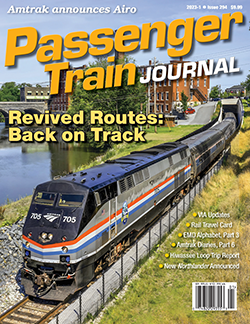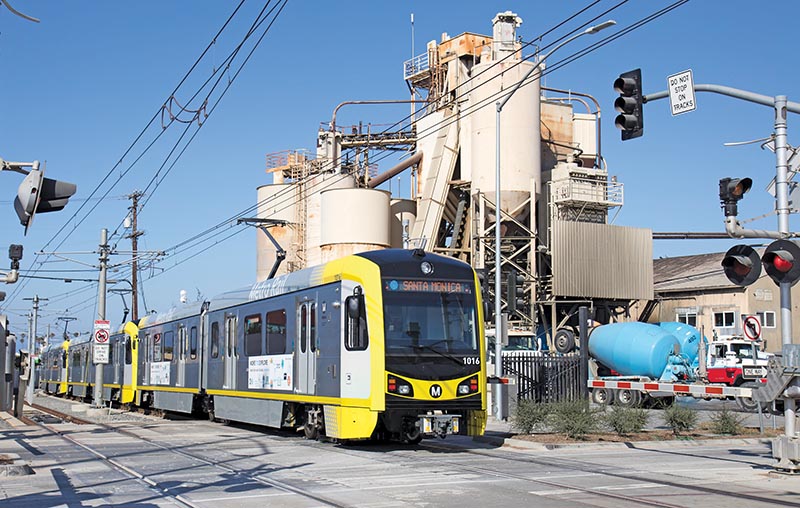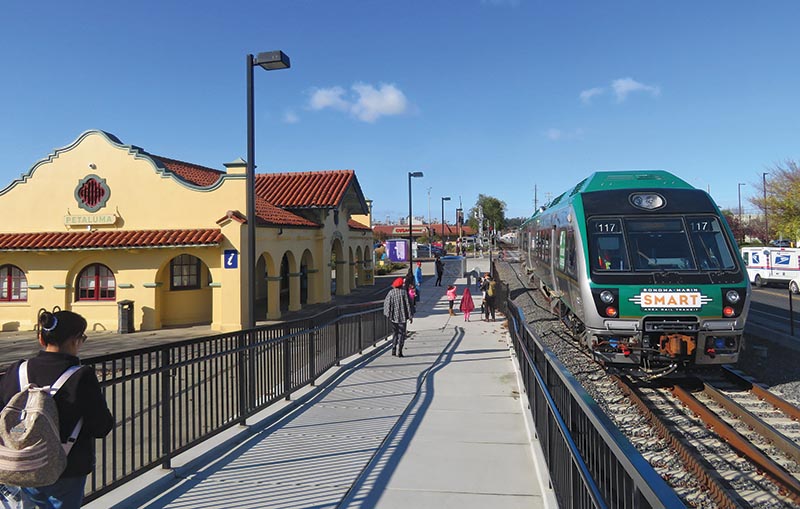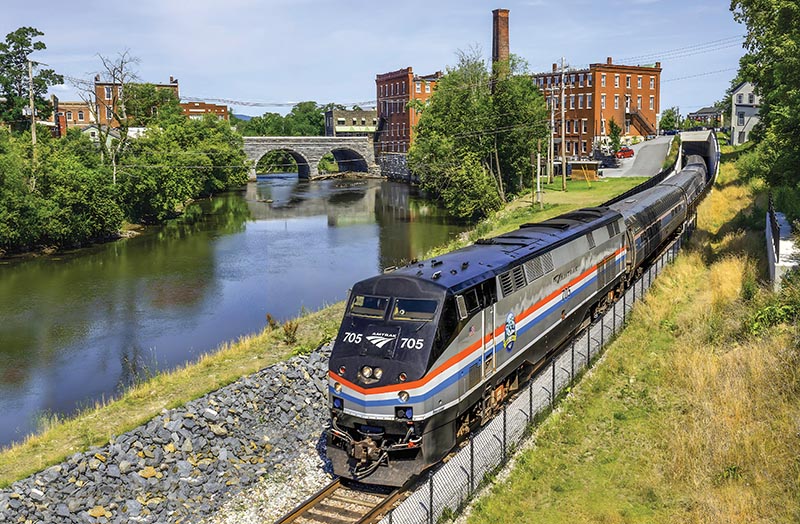 by Joseph P. Schwieterman/photos as noted
by Joseph P. Schwieterman/photos as noted
Mention certain cities when conversing with longtime Passenger Train Journal readers, and particular rail lines often spring to mind. Harrisburg, Pa., may elicit anecdotes about the former Pennsylvania Railroad Main Line. Mention Cleveland, and the ex-New York Central “Water Level Route” is frequently brought to the fore. If the topic turns to San Diego, Calif., expect a remark about Atchison, Topeka & Santa Fe’s “Surf Line”, once graced by the San Diegans and now the Pacific Surfliners.
The trains, signal systems, and operating practices on these corridors, of course, have changed since the days of the fallen flags, but the past and present remain firmly coupled. The progression of railroading has mostly been gradual and linear, like a train negotiating straight track on a gentle grade.
In some locales, though, the evolution of railroads has been like a zigzag. Railroading has had fits and starts, like riding a train on a switchback: the railroad era was brought to a halt, made a reverse move through abandonment, and then started up again on a different alignment. In some towns, the termination of passenger and then freight service was followed by the removal of the last of the tracks. Then, years later, railroading returned in the form of modern light-rail service on a completely different right-of-way.
Consider Herndon, Va., the rapidly growing Washington, D.C., suburb. Herndon was once an important station on the Washington & Old Dominion Railroad, which linked the Potomac River to Bluemont, Va. The idiosyncratic carrier transitioned from steam to electric catenary in the 1910s, making it part interurban, part conventional railroad. But as W&OD’s finances weakened, it transitioned to diesel power in the 1940s and dropped passenger service in 1951. Local freight service eventually folded, too, resulting in its abandonment in 1968. Herndon vanished from railroad maps, and W&OD’s former route was largely fashioned into a recreation trail.

ABOVE: An eastbound LA Metro Expo (E) Line train passes Santa Monica’s Associated Ready Mixed Concrete plant, a legacy of the industrial orientation of Pacific Electric’s “Santa Monica Air Line” corridor, on August 13, 2016. The Air Line’s preservation after the cessation of freight service during the late 1980s greatly abetted the light-rail line’s construction. —Charles Freericks
Yet Herndon is now seeing a rail-passenger revival, thanks to Washington Metro’s new Silver Line extension, which opened for service on November 15, 2022. This heavy-rail line follows a different alignment than W&OD, being in the median of the Dulles Access Road, which was designed for this purpose, and uses a different technology (electrified third rail). Unlike its rural predecessor, the Metro will cater to commuters arriving by bus and motorists using Herndon Station’s 300-space parking deck. Even so, the similarities are striking. Both routes ran through the heart of Fairfax County and reached the Potomac tidal basin. Silver Line trains will eventually run as far west as Ashburn, Va., which also hasn’t seen a train since W&OD’s final days.
Many cities in which rail activity ended and then later resumed have a more straightforward story than Herndon, on account of the role of abandoned routes in the local rail-service renaissance. Consider Lakewood, Colo. (population 155,984), which regained service with the reopening of Regional Transportation District of Metropolitan Denver’s W Line into town in 2013. The light-rail route largely follows an abandoned Denver & Intermountain Railway right-of-way, which saw freight traffic dwindle before being acquired by RTD in the 1990s. Today, trains operate roughly every 15 minutes during busy weekday hours, and prior to the pandemic annual ridership topped at four million.
A few cities with such stop-and-re-start patterns were formerly along Amtrak routes. One such place is Arcadia, Calif. (population 57,939), which was on Santa Fe’s Pasadena Line, used by the carrier’s famed Chief streamliners on their approach into Los Angeles. Santa Fe passenger trains had made their last stop in Arcadia by the early 1960s, but the procession of streamliners continued. Amtrak’s Desert Wind and Southwest Chief rolled through town without stopping (although they did call on near-by Pasadena), but activity on the line diminished after the Wind was annulled in 1986 and the Chief was rerouted via Fullerton, Calif., in 1994. Freight train activity through Arcadia eventually ceased too, but, thankfully, the right-of-way was preserved by LA Metro for its Gold Line Foothill Extension, a planned light-rail route. In 2016, the first LA Metro train-set rolled into Arcadia over freshly built tracks on the ex-Santa Fe line. You can also once again ride a train to Pasadena via LA Metro’s Gold Line, which also largely follows the former path of the Chiefs.

ABOVE: Old and new meet at Petaluma, Calif., where a northbound Sonoma-Marin Area Rail Transit (SMART) DMU train departs beside the former Southern Pacific (Northwestern Pacific) Mission-style depot in December 2019. —Wikimedia
The gap between service is sometimes so long that few residents who witnessed the first era of railroads were still alive when the second began. This category includes West Valley City, Utah, a booming suburb in metropolitan Salt Lake City. Service on the TRAX Green Line, a light-rail corridor, came to town in 2011, which was 66 years after the area’s original rail line, Salt Lake & Utah Railroad, ceased operating. In fact, West Valley City was not even incorporated as a municipality until 34 years after that short-lived rail line ended operations in 1946. With a population of 140,230, the suburb, as far as I can tell, is the most populous city on the U.S. mainland in which all rail activity ended and then passenger service resumed primarily on a “virgin” rail corridor (i.e., one not previously used by a railroad).
By my estimate, at least 100 towns and cities across the U.S. mainland having populations of 500 or more ceased having active rail lines within their legal boundaries for two years or more before having rail activity resume between 2004 and late 2022. The definition of “active rail line” I employ is a set of tracks used by equipment with flanged steel wheels on steel rails, conveying freight or pas-sengers to another community with a population of 500 or more. Details can be found in my Back on Track report, on the Chaddick Institute website. In about a quarter of the communities, the renaissance came in the form of new rail-transit lines. Most of the rest involve freight and heritage railways, in which dormant tracks were restored without the need to re-lay the rails and crossties. “We can thank planners who years ago had the foresight to preserve corridors seen as having little value,” notes Mark Walbrun, a senior railroad consultant with Quandel Associates in Chicago…



